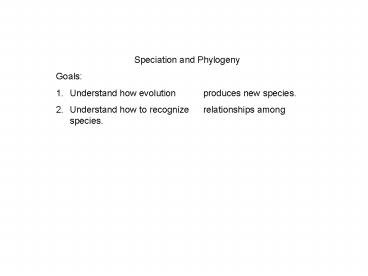Speciation and Phylogeny - PowerPoint PPT Presentation
1 / 31
Title:
Speciation and Phylogeny
Description:
... evolution produces new species. Understand how to recognize relationships among species. ... This is the same as the question, Where do new species come from? ... – PowerPoint PPT presentation
Number of Views:26
Avg rating:3.0/5.0
Title: Speciation and Phylogeny
1
- Speciation and Phylogeny
- Goals
- Understand how evolution produces new species.
- Understand how to recognize relationships among
species.
2
Speciation Where do new species come
from? First, what is a species? Defined by
reproductive isolation. Members of different
species dont share genes they cant interbreed.
3
But, all organisms are connected in an unbroken
ancestor-descendant chain, back to the first
gene-based life forms! So how is that the various
descendants become reproductively isolated? All
living chimps and all living humans share an
ancestor so why cant we breed with chimps?
4
This is the same as the question, Where do new
species come from? It is a question about the
origins of reproductive isolation. The simplest
explanation (though not the only one) is called
the allopatric model.
5
Allopatric model
Geographic range of species A
6
Allopatric model
Range divided by a physical barrier.
7
Allopatric model
Individuals in the west cant breed with those in
the east.
8
Allopatric model
No passage of genes between two sub-populations.
9
Allopatric model
If environment is different in the east and the
west
10
Allopatric model
Selection might favor different traits in the two
areas
11
Allopatric model
If this went on long enough
12
Allopatric model
Then when the barrier disappeared
The two types might be too different to
interbreed.
13
Any factor that discourages gene flow can serve
in place of the physical barrier. e.g.,
ecological separation within the same geographic
range.
14
- Two lines of evidence suggest that the
accumulation of small change can add up to a
species-level difference - Domestic breeds
- Ring species
15
(No Transcript)
16
(No Transcript)
17
Classification and Phylogeny Classification
clustering organisms in natural
groups. Phylogeny deducing ancestor-descendant
relationships. Principle Classification should
reflect phylogeny.
18
Classification is hierarchical
vertebrates
mammals
birds
primates
swifts
bats
ducks
cetaceans
penguins
19
- But what are the natural groupings?
- They could be inferred from overall similarity?
- Any problems with that?
- What causes similarity between organisms?
- Shared ancestry
- Convergence!
20
(No Transcript)
21
(No Transcript)
22
But what are the natural groupings? The ones
created by evolution, of course. Those that share
a common ancestor. But all life shares a common
ancestor Those with a more recent common
ancestor are more closely related!
23
Cladistic classification is based on order of
speciation.
a b c d
24
a b c d
25
mammals
primates
apes
a b c d
26
Primitive versus derived similarities.
Primitive trait present in the common ancestor
of the group. Derived trait evolved since
divergence from the common ancestor.
27
Primitive versus derived similarities.
Pentadactyly (having 5 digits) is primitive for
mammals. It should not be used to find natural
groups of mammals. But having one toe is derived
for mammals. So those that have one toe may
represent a natural group.
28
- How to decide what is primitive and what is
derived? - Two methods
- fossil record
- out-group comparison
29
- 2 3 4 5 6
species - b a b b a b
trait
Species 6 is the outgroup. Cladistic principle
Trait present in the outgroup is primitive.
30
- 5 1 3 4 6
Species - a a b b b b
Traits
Species 6 is the outgroup. Cladistic principle
Trait present in the outgroup is
primitive. Derived traits show recent ancestry.
31
This process can be repeated for other
(phenotypic or genetic) traits. Not all traits
will give the same answer but each trait can
count as a vote for one grouping arrangement or
another. The arrangement that gets the most votes
wins Maximum parsimony.































